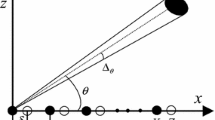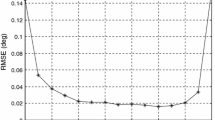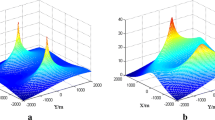Abstract
The signal source generates angular expansion in space due to scattering, reflection and other phenomena in a complex environment, which requires a distributed signal model for processing. This paper extends the method of joint angular estimation for coherently distributed (CD) sources consisting of noncircular signals to the impulsive noise scenario. In an actual wireless passive positioning environment, impulsive noise is very common. However, most algorithms only consider Gaussian noise environments and are not suitable for angle estimation in impulsive noise scenarios. This paper proposes the generalized complex correntropy (GCC) and shows that it can eliminate the effects of outliers in an impulsive noise environment. This is because the complex correntropy is an effective tool to analyze higher-order statistical moments in the impulsive noise environment. In order to improve the accuracy of the estimation, we construct a GCC matrix based on extended array output and apply the subspace techniques to extract the angle information of the CD noncircular sources. The simulation results show that the estimation performance of the proposed algorithms is better than the traditional algorithm applied to the noncircular CD sources.






Similar content being viewed by others
References
Ma, F., Zhang, X.: Wideband DOA estimation based on focusing signal subspace. Signal Image Video Process. 13(4), 675–682 (2018)
Astély, D., Ottersten, B.: The effects of local scattering on direction of arrival estimation with MUSIC. IEEE Trans. Signal Process. 47(12), 3220–3234 (1999)
Valaee, P.K.S., Champagne, B.: Parametric localization of distributed sources. IEEE Trans. Signal Process. 43(9), 2144–2153 (1995)
Adali, T., Schreier, P.J., Scharf, L.L.: Complex-valued signal processing: The proper way to deal with impropriety. IEEE Trans. Signal Process. 59(11), 5101–5125 (2011)
Picinbono, B.: On circularity. IEEE Trans. Signal Process. 42(12), 3473–3482 (1994)
Gounon, P., Adnet, C., Galy, J.: Angular localisation for noncircular signals. Trait. du Signal 15(1), 17–23 (1998)
Wan, L., Han, G., Jiang, J., et al.: DOA estimation for coherently distributed sources considering circular and noncircular signals in massive MIMO systems. IEEE Syst. J. 11(1), 41–49 (2017)
Yang, X., Li, G., Zheng, Z., et al.: 2D DOA estimation of coherently distributed noncircular sources. Wirel. Pers. Commun. 78(2), 1095–1102 (2014)
Liu, T., Qiu, T., Luan, S.: Cyclic correntropy: foundations and theories. IEEE Access 6, 34659–34669 (2018)
Shao, M., Nikias, C.L.: Signal processing with fractional lower order moments: Stable processes and their applications. Proc. IEEE 81(7), 986–1010 (1993)
Belkacemi, H., Marcos, S.: Robust subspace-based algorithms for joint angle/Doppler estimation in non-Gaussian clutter. Signal Process. 87(7), 1547–1558 (2007)
Jinfeng, Z., Tianshuang, Q.: A novel covariation based noncircular sources direction finding method under impulsive noise environments. Signal Process. 98, 252–262 (2014)
Tian, Q., Qiu, T., Ma, J., et al.: A simplified DOA estimation method based on correntropy in the presence of impulsive noise. IEEE Access 6, 67010–67025 (2018)
Zhang, J., Qiu, T., Song, A., et al.: A novel correntropy based DOA estimation algorithm in impulsive noise environments. Signal Process. 104, 346–357 (2014)
Liu, W., Pokharel, P.P., Principe, J.C.: Correntropy: properties and applications in non-Gaussian signal processing. IEEE Trans. Signal Process. 55(11), 5286–5298 (2007)
Guimaraes, J.P.F., Fontes, A.I.R., Rego, J.B.A., et al.: Complex correntropy: probabilistic interpretation and application to complex-Valued data. IEEE Signal Process. Lett. 24(1), 42–45 (2017)
Schmidt, R.: Multiple emitter location and signal parameter estimation. IEEE Trans. Antennas Propag. 34(3), 276–280 (1986)
Gunduz, A., Principe, J.C.: Correntropy as a novel measure for nonlinearity tests. Signal Process. 89(1), 14–23 (2009)
Acknowledgment
This work was supported by the National Natural Science Foundation of China under Grant 61671105, Grant 61139001, Grant 61172108 and Grant 81241059.
Author information
Authors and Affiliations
Corresponding author
Additional information
Publisher's Note
Springer Nature remains neutral with regard to jurisdictional claims in published maps and institutional affiliations.
Appendix: The Proof of the boundedness of GCC
Appendix: The Proof of the boundedness of GCC
Here, we can rewrite the GCC operator as:
Analysis of (B1) as follows
As mentioned above that let \( C_{1} \) and \( C_{2} \) be i.i.d. SαS complex random variables, under this assumption \( C_{1} \) and \( C_{2}^{*} \) must be also i.i.d. So we have
From [10] we know that for the SαS random variable \( X \) with the characteristic exponent \( 1 < \alpha \le 2 \), there exists
\( \varGamma \left( \cdot \right) \) is the gamma function defined by \( \varGamma \left( x \right) = \int_{0}^{\infty } {t^{x - 1} e^{ - t} {\text{d}}t} \).
Obviously substituting \( p \) with 1 in (B4) can get a finite value \( E[|C_{1} |] \le + \infty \). So
which means that \( V_{\text{GCC}} \) is bounded.
Rights and permissions
About this article
Cite this article
Chao, L., Qiu, T., Tian, Q. et al. Parameter estimation for coherently distributed noncircular sources under impulsive noise environments. SIViP 14, 1497–1505 (2020). https://doi.org/10.1007/s11760-020-01687-3
Received:
Revised:
Accepted:
Published:
Issue Date:
DOI: https://doi.org/10.1007/s11760-020-01687-3




